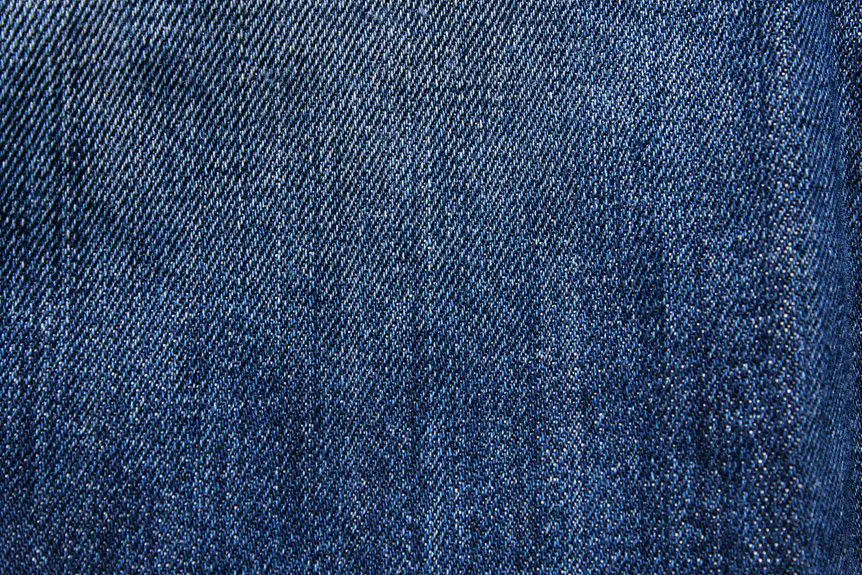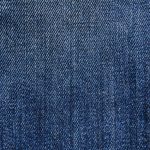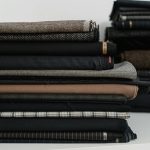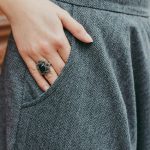Herringbone fabric is a durable, stylish textile recognized by its broken zigzag pattern created through a twill weave that alternates direction. You’ll often find it woven from wool, cotton, or blends, offering warmth, texture, and strength. It’s perfect for blazers, coats, and accessories, fitting both casual and formal looks. Thanks to its unique design and versatility, herringbone brings timeless elegance and resilience to your wardrobe. Explore more to discover its rich history, fabric choices, and styling tips.
Table of Contents
Key Takeaways
- Herringbone fabric features a distinctive broken zigzag pattern created by alternating the direction of the twill weave.
- Traditionally woven from wool, cotton, silk, or synthetic blends, it balances durability with style and comfort.
- Its unique V-shaped pattern adds texture and visual interest, making it popular for suits, outerwear, and accessories.
- The weave enhances fabric strength and resilience by evenly distributing stress and maintaining shape over time.
- Herringbone differs from chevron and simple twill by its broken zigzag design that offers dynamic texture and classic appeal.
The Origin and History of Herringbone Fabric
Although you might recognize herringbone fabric from modern fashion, its history stretches back centuries to ancient civilizations. You’ll find that the distinctive V-shaped pattern, resembling fish bones, was first used by the Romans in road construction and later in textiles.
Over time, this design made its way into clothing, especially in Europe, where it became a staple for tweed fabrics. When you wear herringbone, you’re connecting with a tradition that values durability and style.
The pattern’s strength and visual appeal made it popular among hunters and outdoor enthusiasts in the 19th century. Now, it’s a timeless choice for suits, jackets, and more, blending historical craftsmanship with contemporary fashion seamlessly.
Understanding the Herringbone Weave Pattern
When you look closely at herringbone fabric, you’ll notice its unique zigzag pattern, created by alternating the direction of the weave. This distinctive design forms a V-shaped pattern resembling fish bones, which is where the name “herringbone” comes from.
The weave uses a twill technique, meaning threads run diagonally across the fabric. However, unlike a simple twill, herringbone reverses the diagonal direction regularly, producing that characteristic broken zigzag effect.
You’ll find this pattern not only visually appealing but also functional, as it adds texture and durability to the fabric. Understanding this weave helps you appreciate why herringbone is a popular choice for suits, outerwear, and upholstery—it combines style with strength in a way few fabrics can match.
Common Materials Used for Herringbone Fabric
The unique zigzag pattern of herringbone fabric owes much of its appeal to the materials used in its creation.
The distinct zigzag of herringbone fabric is deeply influenced by the choice of materials used.
You’ll often find herringbone woven from wool, which offers warmth and durability, making it ideal for suits, coats, and upholstery.
Cotton is another popular choice, providing breathability and comfort, perfect for lighter garments or casual wear.
You might also encounter herringbone made with silk or linen blends, adding a touch of luxury and texture variety.
Synthetic fibers like polyester sometimes mix in for added strength and wrinkle resistance.
When you choose herringbone fabric, consider the material’s feel and function to match your needs—whether you want cozy winter layers or stylish, breathable spring pieces, the material plays a key role in how the pattern performs and looks.
How Herringbone Fabric Is Manufactured
Creating herringbone fabric involves weaving threads in a distinctive V-shaped pattern that resembles the bones of a herring fish.
You start by setting up the loom with warp threads, which run lengthwise. Then, you weave the weft threads back and forth across the warp, alternating the direction at regular intervals to form the zigzag pattern. This requires precise control to guarantee the angles align perfectly, producing the characteristic broken twill effect.
You can use various fibers like wool, cotton, or synthetic blends, depending on the desired texture and durability.
After weaving, the fabric often undergoes finishing processes such as washing or pressing to enhance its feel and appearance.
Characteristics and Benefits of Herringbone Fabric
You’ll notice herringbone fabric’s distinctive zigzag pattern adds both texture and visual interest to any piece.
It’s built for durability and strength, making it a smart choice for long-lasting wear.
Plus, its versatile style fits effortlessly into both casual and formal settings.
Distinctive Zigzag Pattern
Herringbone fabric stands out with its distinctive zigzag pattern, which not only adds visual interest but also enhances durability.
When you look closely, you’ll notice the pattern resembles a broken zigzag, formed by alternating diagonal lines. This classic design gives the fabric a timeless appeal that fits both casual and formal styles.
Here’s why the zigzag pattern matters:
- Visual Texture: The alternating angles create a subtle texture that catches the eye without overwhelming your outfit.
- Versatility: Its understated pattern works well with various colors and fabrics, making it easy to pair.
- Depth and Dimension: The design adds a three-dimensional effect, giving your clothing or upholstery more character and sophistication.
This pattern makes herringbone fabric a go-to choice for those who appreciate both style and function.
Durability and Strength
The distinctive zigzag pattern not only adds style but also reinforces the fabric’s structure, making it tougher and more resilient.
When you choose herringbone fabric, you’re getting a weave that resists wear and tear better than many alternatives. Its interlocking design distributes stress evenly, so it holds up well against frequent use and washing.
You’ll notice that garments made from herringbone maintain their shape and texture longer, reducing the need for frequent replacements. This durability makes herringbone an excellent choice for everything from suits to upholstery.
Plus, the fabric’s strength doesn’t come at the cost of comfort—you still get a soft, breathable material that performs well day after day.
Versatile Style Options
Although it’s known for durability, herringbone fabric also offers impressive versatility in style. You can easily incorporate it into various looks, whether for casual or formal occasions. Its unique zigzag pattern adds subtle texture without overwhelming your outfit.
Here’s how you can style herringbone fabric:
- Suits and Blazers – Perfect for a sharp, professional appearance with a twist.
- Outerwear – Use it in coats or jackets for a classic, timeless vibe.
- Accessories and Home Decor – Think scarves, hats, or even throw pillows to add elegance and warmth.
No matter your style preference, herringbone fabric adapts effortlessly, making it a smart and stylish choice you’ll appreciate.
Popular Uses of Herringbone in Fashion and Design
When you spot that distinctive zigzag pattern, you’re likely looking at herringbone fabric, a favorite in both fashion and interior design.
In fashion, you’ll find it in tailored blazers, coats, and trousers, offering a timeless, sophisticated look. It adds subtle texture to your outfit without overwhelming it. Designers also use herringbone for scarves and hats, giving your accessories a classic twist.
In interiors, you’ll see herringbone in upholstery, curtains, and even rugs, adding depth and elegance to your space. Its structured pattern complements both modern and traditional decor styles.
Whether you’re dressing up or decorating your home, herringbone fabric brings a refined, versatile charm that’s hard to beat. It’s a smart choice when you want understated style with lasting appeal.
Caring for and Maintaining Herringbone Fabric
Using herringbone fabric in your wardrobe or home means you’ll want to keep it looking its best.
To maintain its distinctive texture and pattern, follow these simple steps:
- Gentle Cleaning: Always use a mild detergent and cold water when washing herringbone fabric. Avoid harsh chemicals or bleach that can damage the fibers.
- Proper Drying: Air dry your herringbone items flat or hang them to prevent distortion. Avoid high heat in dryers, which can shrink or warp the fabric.
- Regular Brushing: Use a soft brush to remove dust and dirt from the fabric’s surface, preserving its sharp zigzag pattern and preventing dullness.
Comparing Herringbone With Other Weave Patterns
When you compare herringbone with chevron, you’ll notice subtle differences in their zigzag patterns.
Herringbone creates a broken V shape, while chevron forms a continuous zigzag.
Understanding how herringbone differs from twill can also help you choose the right fabric for your project.
Herringbone vs. Chevron
Although herringbone and chevron patterns might look similar at first glance, you’ll notice key differences that set them apart once you examine their weave structures closely.
Herringbone features a broken zigzag with a subtle V-shape, while chevron displays a continuous zigzag with a sharp, pointed pattern.
Here’s how you can tell them apart:
- Pattern Breaks: Herringbone has a distinct break in the zigzag, creating a stepped effect; chevron is seamless and flows continuously.
- Visual Texture: Herringbone’s weave adds texture and depth; chevron appears flatter and more graphic.
- Use in Fabric: Herringbone often appears in tweeds and suiting fabrics; chevron is common in prints and upholstery.
Understanding these differences helps you choose the right pattern for your style or project.
Twill and Herringbone Differences
Patterns like herringbone and chevron show how subtle changes in weave impact fabric appearance.
When comparing twill and herringbone, you’ll notice twill features a simple diagonal pattern, while herringbone breaks that diagonal into zigzag shapes. Twill’s uniform slant gives it a smooth, consistent look, perfect for classic denim or suits.
Herringbone, however, adds texture and visual interest with its broken twill design, making the fabric appear more dynamic. Both use the twill weave technique, but herringbone’s alternating direction sets it apart.
If you want a fabric that’s durable yet visually striking, herringbone is a great choice. On the other hand, twill offers a timeless, understated elegance.
Understanding these differences helps you pick the right fabric for your style and needs.
Styling Tips: Incorporating Herringbone Into Your Wardrobe
Incorporating herringbone into your wardrobe adds texture and sophistication to your outfits without overwhelming your look.
To style it effectively, consider these tips:
- Start with outerwear: A herringbone blazer or coat instantly elevates your ensemble, pairing well with both casual jeans and professional trousers.
- Mix with solids: Balance herringbone patterns by combining them with solid colors to keep your outfit clean and focused.
- Play with accessories: Incorporate herringbone scarves or hats to add subtle interest without committing to a full garment.
Frequently Asked Questions
Can Herringbone Fabric Be Used for Upholstery Projects?
You’ll transform any dull room into a dazzling masterpiece with herringbone fabric! It’s durable and stylish, perfect for upholstery projects. Just imagine your furniture boasting that timeless, textured pattern everyone’s going to admire instantly!
Is Herringbone Fabric Suitable for All Seasons?
You’ll find herringbone fabric versatile for most seasons since its weave offers breathability and warmth. However, heavier weights suit colder months, while lighter versions keep you comfortable during warmer weather. Choose accordingly!
How Does Herringbone Fabric Perform in Outdoor Clothing?
You might be surprised how well herringbone performs outdoors. Its durable weave resists wear, keeps you warm, and breathes just enough. When you’re outside, it balances comfort and toughness like a hidden champion.
Are There Synthetic Alternatives to Traditional Herringbone Fabric?
You can find synthetic alternatives to traditional herringbone fabric like polyester or nylon blends. They mimic the pattern while offering durability, moisture-wicking, and quick-drying properties, making them great for outdoor gear and activewear.
What Is the Environmental Impact of Producing Herringbone Fabric?
Picture fields and factories—producing herringbone fabric can drain water, consume energy, and emit pollutants. You’ll want to choose eco-friendly fibers and sustainable methods to lessen your environmental footprint while enjoying the classic weave.
- Ombre vs. Dip Dye: Understanding the Nuances - July 13, 2025
- Crumple vs. Spiral Tie-Dye: What’s the Difference? - July 13, 2025
- The Complete Guide to Tie-Dye Folding and Binding - July 13, 2025







